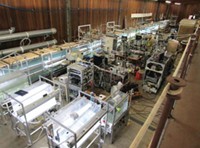Advertisement
Grab your lab coat. Let's get started
Welcome!
Welcome!
Create an account below to get 6 C&EN articles per month, receive newsletters and more - all free.
It seems this is your first time logging in online. Please enter the following information to continue.
As an ACS member you automatically get access to this site. All we need is few more details to create your reading experience.
Not you? Sign in with a different account.
Not you? Sign in with a different account.
ERROR 1
ERROR 1
ERROR 2
ERROR 2
ERROR 2
ERROR 2
ERROR 2
Password and Confirm password must match.
If you have an ACS member number, please enter it here so we can link this account to your membership. (optional)
ERROR 2
ACS values your privacy. By submitting your information, you are gaining access to C&EN and subscribing to our weekly newsletter. We use the information you provide to make your reading experience better, and we will never sell your data to third party members.
Materials
Airborne Mineral Dust Is Key To Cirrus Cloud Creation
Understanding cloud formation will improve climate modeling
by Jyllian Kemsley
May 13, 2013
| A version of this story appeared in
Volume 91, Issue 19
Clouds play a key role in climate by reflecting solar radiation and by trapping heat from Earth. Understanding how clouds form is critical to modeling climate effects. Studies reveal that airborne mineral dust and metal particles are essential for forming cirrus clouds, which are wispy and found in high altitudes (Science 2013, DOI: 10.1126/science.1234145). A group led by Daniel J. Cziczo of Massachusetts Institute of Technology studied cirrus ice crystals during four aircraft measurement campaigns from 2002 to 2011. The researchers found that most of the particles in the air near clouds are made of sulfate and organic carbon. They also found that in the cloud formation process, ice preferentially condenses on aluminosilicate dust or metal particles. The results point to a heterogeneous ice nucleation mechanism in clouds, akin to getting a compound to crystallize from solution by scratching the beaker, rather than a homogeneous mechanism in which ice nucleates without a substrate.




Join the conversation
Contact the reporter
Submit a Letter to the Editor for publication
Engage with us on Twitter